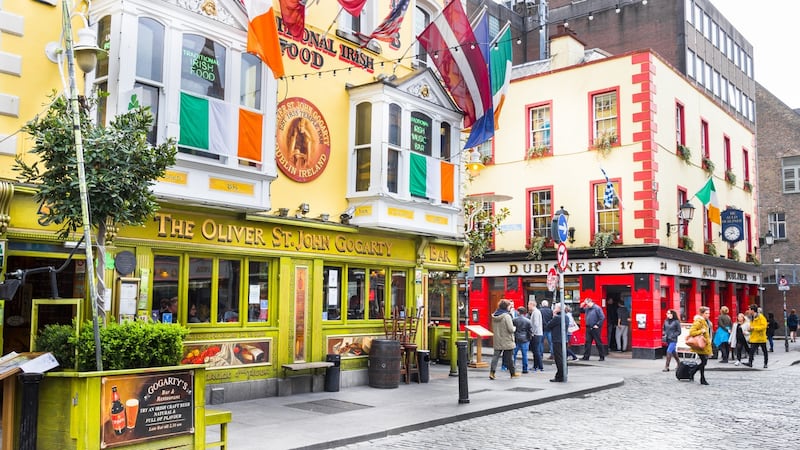In the age of Zoom, many of us have spent less time walking the streets of the capital than we would have before. The city that Joyce christened the “Hibernian Metropolis” fell unusually quiet, feeling more like the Hibernating Metropolis. But now she awakens, and Culture Night offers a chance for locals and visitors alike to explore the city in new and exciting ways.
Culture Night highlights what is around us all year – a city of heritage and history – by swinging open the doors of the city’s cultural institutions and enticing us inside for a look. This year, there are more than 250 free in-person and online events in more than 200 venues. On both sides of the Liffey, and beyond the city centre too, the programme has something to appeal to all ages and backgrounds.
Music has been absent from our lives in a way deeply unfamiliar to the city in recent times. On Culture Night, the doors of Na Píobairí Uilleann on Henrietta Street open, inviting us in to explore the Georgian building that houses the society of Irish pipers.
The city that one sees from the Liffey today is modern and seemingly ever-expanding, far removed from the Dublin of poet Louis MacNeice
The uileann pipes, synonymous with the playing of Séamus Ennis, Leo Rowsome and Liam Óg O’Flynn, are an instrument packed with history, and since the 1960s Na Píobairí Uileann have committed themselves to the promotion and preservation of that musical craft. Their neighbour, 14 Henrietta Street, has come to be known colloquially in the city as “the tenement museum”.
In truth, it is something much broader than that, a museum that centres a building in the telling of social history and uses its detail to tell the story of the city, from Georgian grandeur to tenement decline. Few buildings can tell the story of Dublin’s Georgian elite and her discarded working class in one tour, but this house certainly can.
Crossing the Liffey, Culture Night offers the potential to do so on a historic Liffey ferry. Once a familiar sight to generations of Dubliners, the No 11 ferry was decommissioned with the arrival of the East Link Bridge, but has now been restored to its former glory. Dublin’s historic Liffey ferry service can trace its origins back to a Royal Charter of 1665, and while Liffeyside has been physically transformed in recent decades, the ferry offers unique views of familiar landscapes like the Samuel Beckett Bridge, Poolbeg stacks and more besides.

The city that one sees from the Liffey today is modern and seemingly ever-expanding, far removed from the Dublin of poet Louis MacNeice, and the “grey brick upon brick” with which he fell in love. But his words, of how “The lights jig in the river, with a concertina movement” might be recalled instead. At Bedford Lane in Temple Bar, artists Kevin Bohan and lljin will be live-painting two pieces in response to that very MacNeice poem.
Other literary figures are honoured at the Icon Factory and the Icon Walk, a reminder that even today there are pockets of bohemian art culture found within Temple Bar. At Meeting House Square, the Gallery of Photography presents the Hope cycle from the Prix Pictet, the world’s leading award for photography around sustainability.
Showing images previously displayed in London, Tokyo, Zurich, and Tel Aviv, the gallery continues its commitment of bringing the best of international photography to Irish eyes. Nearby, at the Brick Alley Cafe on Essex Street, images of Havana by Irish photographer Peter O’Doherty capture a society in transition, taken in early 2020 before international lockdowns began.
2021 marks the bicentenary of the birth of Lady Jane Wilde, known in her lifetime as Speranza, a pen-name borrowed from the Italian word for hope. A firebrand nationalist, a poet, a folklorist and a committed supporter of the rights of women in society, she was also mother to Oscar Wilde. Her family home was a centre of political debate and cultural discussion, hosting visitors as diverse English suffrage campaigner Millicent Fawcett and Dracula author Bram Stoker. Now known as Oscar Wilde House, Culture Night allows us to step inside Speranza’s Salon.
For more than a year now, the front gate of Trinity College Dublin has been closed to us. A favourite shortcut, from College Green to Nassau Street, gone
Oscar Wilde had a brief engagement with the Freemasons in his student days, joining the Apollo University Lodge at Oxford University. That Wilde was a Freemason is little-known in Ireland today, and likewise the membership of Daniel O’Connell. At 17 Molesworth Street, the Grand Lodge of Ireland invite the public to visit Freemason’s Hall on Culture Night. Viewing the building from across the street, the Square and Compasses – symbol of Freemasonry – is visible in the building’s detail. Inside, the building is a curious but fascinating mix of architectural styles throughout. We learn of the chessboard carpet, which “stands for the good and evil through which members walk in life”. You won’t come away knowing everything about the freemason’s, but you’ll certainly learn a lot.
Nearby, Leinster House joins the Online programme with a virtual tour. 2021 marks the 30th birthday of the Irish Museum of Modern Art (IMMA), a museum that grew from the remarkable collection of private-collector Gordon Lambert, and which houses some of the best in Irish and international modern art.
Nestled in the grounds of the Royal Hospital Kilmainham, the museum avails not only of the stunning 17th century architecture it has inherited, but also the surrounding grounds. In Place, by Croí Glan Integrated Dance, is a chance to see a unique outdoors live performance, while indoors is Ghosts from the Recent Past, inviting us to see artworks from IMMA’s collection in the context of our changing world over three decades, both locally and internationally.
The printed word is at the heart of our history – be it in the form of literature or political proclamation. The National Print Museum at Beggars Bush Barracks is the kind of museum that makes us rethink things. Having recently collaborated with artist Maser on the project Parallels, exploring the 1916 Proclamation, the museum opens its doors now to those wishing to learn about the skill and craft of printing. Would Irish history be quite the same without the Wharfedale Stop Cylinder Press that proclaimed our Republic? Maser’s own gallery, Atelier Now, opens its doors on Charlemont Street on the night.
Speaking of printers – it is to the great shame of Dublin that when Joyce’s Ulysses rolled off the printing presses, it was the name of Shakespeare and Company, the Parisian publisher, which adorned it. Next year marks the centenary of Joyce’s ode to Dublin. At the Museum of Literature Ireland (MoLI), they seek to demystify the story of June 16th, 1904, and to explore Ireland’s rich literary heritage beyond Ulysses. One of Dublin’s newest museums, its stunning rear garden allows visitors to stand at the very same tree where a young Joyce posed with his fellow University College Dublin graduates in 1902.
And what of that other nearby university, the one that remains in the heart of the city? For more than a year now, the front gate of Trinity College Dublin has been closed to us. A favourite shortcut, from College Green to Nassau Street, gone, until it was reopened this month. Culture Night invites us back onto the campus of Dublin’s oldest university again. Its Geological Museum – a chance to see the skeleton of a giant Irish Deer – is a hidden treasure of the city. There’s also a chance to take a guided tour of the campus as Gaeilge.
Perhaps the tours will visit the statue of former Provost George Salmon, whose hostility to female students was somewhat legendary. In his time, the Board insisted that “if a female had once passed the gate ... it would be practically impossible to watch what buildings or what chambers she might enter, or how long she might remain there.” Since the gates of the college last opened to the general public, Trinity has appointed its first female Provost. Cities are ever-changing.
Culture Night takes place on September 17th. Visit culturenightdublin.ie for details. Donal Fallon presents the Three Castles Burning podcast and is a former Historian in Residence to Dublin City Council
Five picks for Culture Night
- Cultural Tour of Bewley's on Grafton Street: A chance to see some of Dublin's finest stained-glass windows, including work by Harry Clarke and Jim Fitzpatrick.
- Damn Fine Print: One of Dublin's leading printers open their doors for live screenprinting and Risograph printing demonstrations.
- Garda Museum, Dublin Castle: Finally in a new home within the Castle grounds, this museum tells the story of Irish policing.
- Little Streets Upon The Great: A walking tour taking in lesser-known sites of importance to Behan, Joyce and more.
- The History of Weaving: In the Liberties at St James's Parish Church with local historian Cathy Scuffil.


















